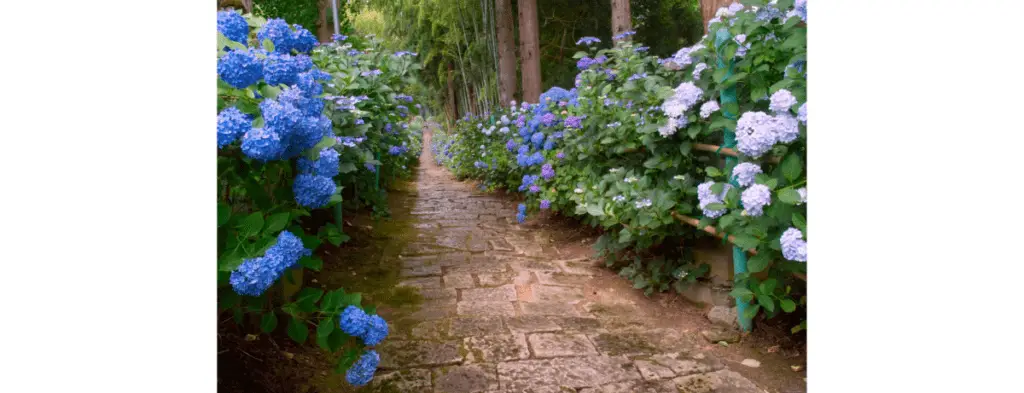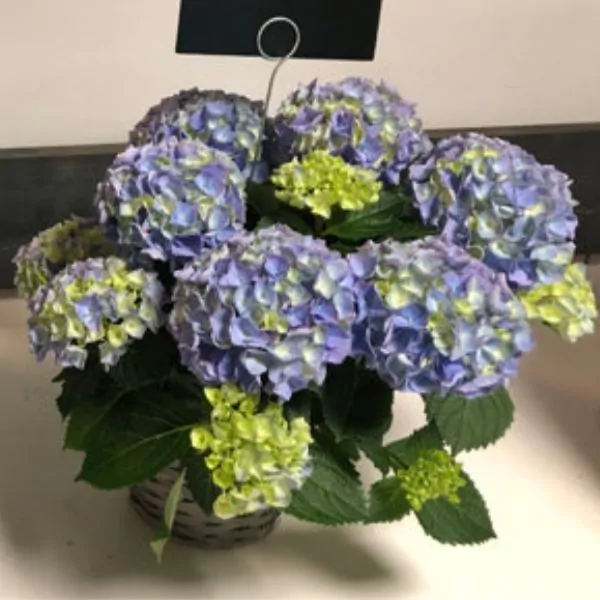
On average you want to make sure you have a forecast of cool weather for at least 6 to 8 weeks after planting. For this reason most gardeners plant Hydrangeas in the fall. The plant needs time to establish a root system before dealing with extreme hot or cold temperatures. Make sure to check for frost dates in your area as frost can kill a freshly planted hydrangea.
How do you plant hydrangeas?
Dig planting holes two feet wider than the base of the plant for each hydrangea you want to plant. Be sure that the hole’s depths is the height of the pot it is being transferred from this will ensure that your plant is either at the same level or slightly higher than the soil around it.
How far apart should you plant hydrangeas?
You should plant a variety of hydrangeas anywhere from three to ten feet apart. Always leave adequate space between plants, considering how large they will grow.
Do hydrangeas grow better in pots or in the ground?
If you’ve researched hydrangea care, you understand that these plants fare best in organic-rich soil that will not dry out during warmer months. Learn more about the best soil amendments in this post! Because of this, they do best when planted in the ground rather than in containers, as the latter tend to dry up much more rapidly. But that doesn’t mean you can’t arrange these flowers beautifully in a container. You have to make sure they get the attention they need, use quality compost, and put them in the correct spot. In addition, some strains fare better in specific settings than others.
How much sunlight do hydrangeas need?
Hydrangeas, in general, do best when given filtered sunlight. In a perfect scenario, they will be exposed to the sun all morning, but then you will provide them some protection from the scorching heat of the midday sun in the afternoon. This would be particularly good for the Bigleaf hydrangea, which is susceptible to wilting due to the huge size of its leaves. Some cultivars can better handle prolonged exposure to direct sunlight. Find out which plants grow best in the shade in this post.
Types of hydrangeas
Hydrangeas are a time-honored flower that are cherished by both amateur and professional gardeners and florists. The huge, spherical flower heads that they possess are what set them apart from other types of flowers. But you might not be aware that there are actually four primary kinds of hydrangeas. The majority of hydrangea species are white, despite the fact that purple and blue hydrangeas are frequently the first colors which come to mind when thinking of this plant. In addition, the leaves of hydrangeas can come in a variety of shapes and sizes, from bigleaf to oakleaf, both of which exhibit vibrant hues during the autumn season.
Oakleaf
As its name suggests, the oakleaf hydrangea‘s (paid link) leaves resemble oak tree leaves. Hydrangea quercifolia is a genus of hydrangeas, and its name comes from the Latin word quercifolia, which means “oakleaf.” Oakleaf hydrangeas are the only hydrangeas with autumnal leaf coloration; their leaves resemble those of oak trees and they are also the only hydrangeas to do so. One of the most visually stunning shrubs to have in your autumn garden is the golden-orange, red, and deep mahogany-leafed twigging hydrangea.
Bigleaf
The most prevalent type of hydrangea is this particular variety. Zones 5 to zone 9 are typical growing conditions for these plants. There are three main types of bigleaf hydrangea:
Mophead Hydrangeas
the most well-known and widespread kind of hydrangea because of the enormous, rounded flower heads that they produce. They flourish in hardiness zone 6, and the color of their blossoms can range from purple to blue to pink. Because mophead hydrangeas‘ (paid link) bloom buds are so susceptible to frost damage, it’s possible that none of them will make it through the winter.
Lacecap Hydrangeas
Lacecap hydrangeas (paid link) are nearly indistinguishable from mophead hydrangeas except for their flowers. A cluster of tiny, fertile flower buds sits at the flower head’s core, and larger, more spectacular flowers bloom around the periphery. These beautiful blooms are actually impotent, serving mainly to draw insects like butterflies and bees to the developing fruit inside the flower. They, too, do well in hardiness zone 6, just like mophead hydrangeas. We cover hardiness zones in this post.
Mountain Hydrangeas
Are a subset of bigleaf hydrangeas that are rather rare. Hydrangea serrata, as its scientific name suggests, looks like lacecap hydrangeas but has smaller blooms and leaves. There are few plants better suited to locations that experience late-winter cold spells than mountain hydrangeas (paid link), thanks to their hardier buds and their ability to flourish in hardiness zone 5.
Panicle
The long panicles that produce the big flowers of the hydrangea species Hydrangea paniculata (paid link) emerge are a distinctive feature of the plant. While most hydrangeas have round flower heads, these cone-shaped panicles can be anywhere from six to eighteen inches in length. White blooms will occur at first, however as the plant matures, the color may change to pink. Panicle hydrangeas are also the hardiest of all hydrangeas, able to survive in USDA plant hardiness zones 4 through 7.
Smooth
The smooth hydrangea, or wild hydrangea, is a plant endemic in the US. This huge shrub, which may reach heights of six feet, is commonly used as a hedge. In reference to its large size and numerous branches, the plant’s scientific term, Hydrangea arborescens (paid link), comes from the Latin word for tree, arbor.
The smooth hydrangea, in contrast to the bigleaf variety, thrives in warm climes and grows well enough in hardiness zones 4 to 9. Flowers tend to be typically white but smaller than those of the bigleaf types, blooming between June and September. Their blossoms are green when they first open, but turn white as they age. As a low-maintenance plant, the smooth hydrangea can tolerate both full sun and moderate shade within the course of a single day.
This post contains affiliate links. If you make a purchase through these links, we may receive compensation at no additional cost to you.




